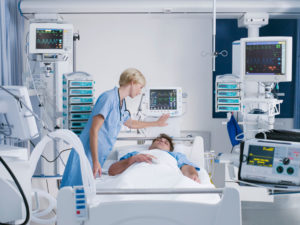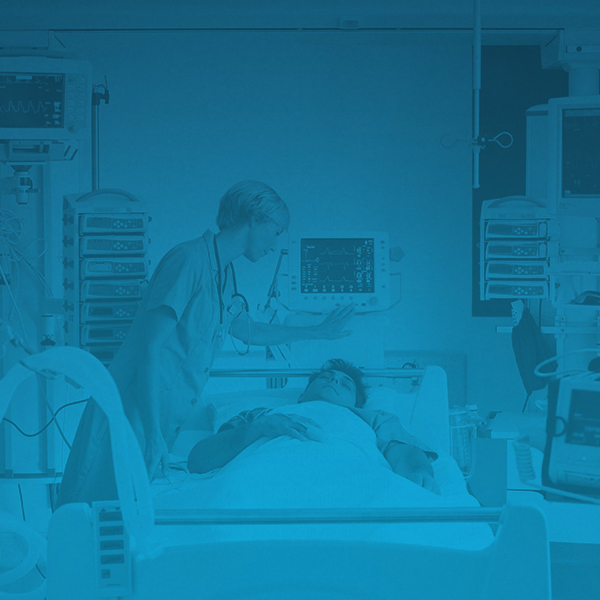What is BLS for Healthcare Providers?
What is BLS for Healthcare Providers?

by Greta Kviklyte
Life Saver, AMC
Co-authored by Kim Murray, RN, M.S.
posted on Jan 26, 2022, at 8:19 am
Did you know? Approximately 200,000 heart attacks occur in hospitals every year, according to 2015 data shared by The National Academies of Science, Engineering, and Medicine. When these heart attacks and other life-threatening emergencies happen, the healthcare providers who work in these medical facilities must have the necessary training, knowledge, and skills to act quickly and help increase the chances of patient survival, no matter their patients’ age. Such knowledge and skills can be acquired by completing a Basic Life Support (BLS) certification.
We offer Online CPR and BLS Certification
Keep reading to learn more about BLS for healthcare providers, including what is BLS, who needs BLS training, the difference between BLS for healthcare workers and lay people, how to prepare for a BLS course, and where you can find a certification course.
What is BLS?

Life-threatening situations where BLS can be used include:
- Choking
- Severe allergic reactions
- Trauma
- Near-drowning
- House fires (e.g., smoke inhalation)
Check out this video for a quick explanation of BLS!
Review These Helpful Definitions:
- Airway Obstruction: any type of blockage in the airway that prevents someone from being able to move air in or out of their lungs (can be caused by a foreign object, trauma, or swelling d/t allergic reactions in the airway)
- Respiratory Distress: an emergency situation in which someone is having a hard time breathing and/or not getting enough oxygen into their lungs, signs, and symptoms of which include increased breathing rate, bluish or purplish discoloration of the lips, fingers, and fingernails, wheezing, grunting, nasal flaring, sweating, sunken chest, and leaning forward
- Sudden Cardiac Arrest (SCA): sudden and unexpected loss of heart function in which the heart stops beating
Some Fast Facts on Life-Threatening Situations
Choking/Airway Obstruction
- According to Statista, the odds of dying from choking in the United States is 1 in 2,535.
- Choking—usually on food—is the fourth leading cause of accidental injury-related death.
- People of all ages can become choking victims, and it is especially common in infants, toddlers, and seniors.
- The universal sign of choking is clutching at one’s throat with one’s hands. Other signs and symptoms of choking include being unable to talk, difficult or noisy breathing, coughing, flushed skin that may turn pale or bluish, a bluish or dusky discoloration to the lips and nails, and loss of consciousness.
Cardiac Arrest
- Of the 350,000+ cardiac arrests that occur outside the hospital every year, 90% of them are fatal.
- The home is the most commonplace for someone to suffer a heart attack, followed by public places and nursing homes.
- Women are less likely to experience sudden cardiac arrest than men but are also less likely to receive CPR when they need it. This could be for several reasons, including the fact that women who have heart attacks are more likely to be older and live alone, and bystanders may be reluctant or scared to do chest compressions due to fear of hurting a female victim, being accused of inappropriate touching or sexual assault. Bystanders may also fail to recognize when a woman is in cardiac arrest, in part due to the misconception that women are “faking it.”
Near-Drowning
- According to the U.S. Centers for Disease Control and Prevention (CDC), drowning is the leading cause of death for children aged 1-4 other than birth defects.
- For kids up to age 14, drowning is also a leading cause of unintentional injury-related death, second only to motor vehicle accidents.
- On average, there are about 22 nonfatal drownings every day and 11 fatal drownings every day in the United States.
- Brain damage can occur in as little as four minutes without oxygen.
Who Needs BLS?
A wide range of healthcare providers should be certified in BLS, including doctors, physician assistants, nurses, nurse practitioners, nursing assistants, EMTs and paramedics, respiratory therapists, chiropractors, optometrists, physical therapists, occupational therapists, and speech-language pathologists. Many healthcare organizations and facilities also require or recommend support staff to be certified in BLS, as well, which can include environmental services or janitorial staff, transport staff, dietary/kitchen staff, laboratory and radiology technicians, chaplains, and guest and volunteer services.
BLS certifications are also becoming increasingly mandatory for some non-healthcare-related professionals, including other types of first responders (police officers, firefighters), teachers, group home staff, daycare employees, lifeguards, construction workers, bus drivers, and camp counselors.
Healthcare providers should understand which certifications they need for their role, not only to remain in compliance with their employers but to ensure they are adequately prepared to help and support their patients in life-threatening situations such as cardiac or respiratory arrest. For some professionals, this could mean that a BLS certification is not sufficient in itself, and additional certifications such as Advanced Cardiovascular Life Support (ACLS), Pediatric Advanced Life Support (PALS), or Blood Borne Pathogens (BBP) will be necessary.
ACLS and PALS certifications are generally required for any healthcare provider working in emergency or critical care settings, including the emergency room (ER) and intensive care unit (ICU). Some nursing homes and other facilities where cardiac arrests are more likely to happen may also require their staff to undergo ACLS training.
Is BLS for Healthcare Workers Different Than Life-Saving Skills Taught to Laypeople?
The main difference between life-saving skills for healthcare workers and laypeople (e.g., non-medical members of the public) is that BLS courses are designed specifically for healthcare workers and go into greater depth than what is taught to laypeople.
Topics covered in BLS for healthcare providers include not only how to perform cardiopulmonary resuscitation (CPR), but also:
- How to provide CPR with more than one rescuer, including with or without the use of manual resuscitators (e.g., bag valve masks or Ambu bags)
- How to use an automated external defibrillator (AED)
- How to provide advanced airway management
- How to provide CPR for infants and children as well as adults
- How to help conscious and unconscious victims who are choking (e.g., back blows and abdominal thrusts)
These foundations are based on the American Heart Association’s (AHA) BLS Chain of Survival and the most recent BLS AHA guidelines and standards. While every course differs in what it offers, the essentials above should adequately prepare health care providers to act in an emergency.
Of course, it’s beneficial for society at large if more people know at least some basic life-saving skills such as CPR. In fact, the American Heart Association reports that bystander CPR can double or triple the chances of survival after out-of-hospital cardiac arrest, which happens as many as 350,000 times per year in the United States! And since AEDs are increasingly common in public spaces—such as airports, grocery stores, casinos, hotels, churches, and gyms—even non-medical lay people should be encouraged to learn how to use these devices. (Keep in mind that with their advanced life support skills, healthcare providers can also save lives while they are out in public or at home, where the majority of cardiac arrests happen.)
Non-medical members of the public who are interested in learning life-saving skills do not necessarily have to enroll in a formal BLS certification course. They may instead opt to complete a more basic CPR, AED & First Aid Certification, which covers many of the same fundamental skills as those learned by healthcare workers, without going into more advanced techniques.
As an example, laypeople are often taught a hands-only CPR technique without rescue breaths (i.e., “mouth to mouth”), which has actually been found to increase the chances of bystanders taking action in an emergency situation at home or in public. Hands-only CPR is also comparable in terms of effectiveness compared to conventional CPR. A 2010 randomized study published in the prestigious New England Journal of Medicine found no difference in 30-day survival rates in victims of out-of-hospital cardiac arrest after receiving standard CPR vs compression-only CPR before the arrival of first responders.
As for healthcare workers, concerns about performing mouth-to-mouth on victims can be mitigated by ensuring that providers have easy and fast access to protective mouth resuscitation barrier devices or bag valve masks.
Preparing for a BLS Certification

- Make sure the course you are signing up for offers the level of training you will need as a healthcare worker
- If taking your BLS certification in-person, ensure that you show up to your class on time
- If taking your BLS certification online, ensure that you have given yourself adequate time to complete the course and that your internet connection is adequate
- Wear comfortable clothing and sturdy footwear, such as your work uniform—this is to ensure you’ll be comfortable participating in the hands-on techniques you’ll be able to practice during your course
- Pay attention and ask questions—chances are, other students in your course will have similar questions about the course material, and your instructor should be more than happy to clarify any confusion
- While taking the examination, read each question thoroughly and carefully
- Ask your instructor or BLS certification provider about when and how to get your proof of certification
- Know when and how you will need to renew your certification (generally, BLS certifications must be renewed every two years)
Where to Complete Your BLS Course
BLS courses can be completed online or in in-person classes. Traditional classroom courses are often taught over the course of a weekend, while online BLS courses generally offer a more convenient, flexible, and cost-friendly option. Online BLS certifications and recertification also offer students the convenience of studying the material on their own time and at their preferred pace, without needing to pass a hands-on skills assessment (although practicing these skills on one’s own is certainly beneficial).
Whether you choose an in-person or online BLS course, it’s important to choose an organization you can trust to provide quality training—and an organization that will grant you a BLS certification that will be recognized by your specific employer or organization.
With a 98% national acceptance rate, BLS certifications from AMC are highly unlikely to be rejected, but we’re happy to offer a full refund if necessary. AMC also takes steps to make it as convenient, affordable, and engaging as possible to earn your BLS certification online by offering high-quality audiovisual modules and supporting resources based on industry-leading standards, such as the International Liaison Committee on Resuscitation (ILCOR) 2020-2025 Edition ACLS Provider Handbook.
In addition, our students have the opportunity to earn continuing medical education (CME) credits, all from the convenience and privacy of their home or workplace.
Conclusion
As a healthcare provider, staying up-to-date with your basic life-saving skills, including CPR, AED, and the abdominal thrust technique, can make the difference between life or death for your patients. Share with us how your basic life-saving skills have helped you.
If you’re ready to complete or renew your BLS certification online or are interested in offering BLS certifications online to your organization’s caregivers, contact Advanced Medical Certification today. We know you have many choices when it comes to developing your life-saving and advanced life support skills, which is why AMC is honored to be one of fewer than 1% of internet sites endorsed by HONcode, a UN-chartered agency that sets ethical standards for the provision of health information for providers, patients, and the public.



